Does Laser Surgery Interfere with Optical Nerve Identification in Maxillofacial Hard and Soft Tissue?—An Experimental Ex Vivo Study
Abstract
:1. Introduction
2. Experimental Section
2.1. Tissue Samples
2.2. Experimental Setup
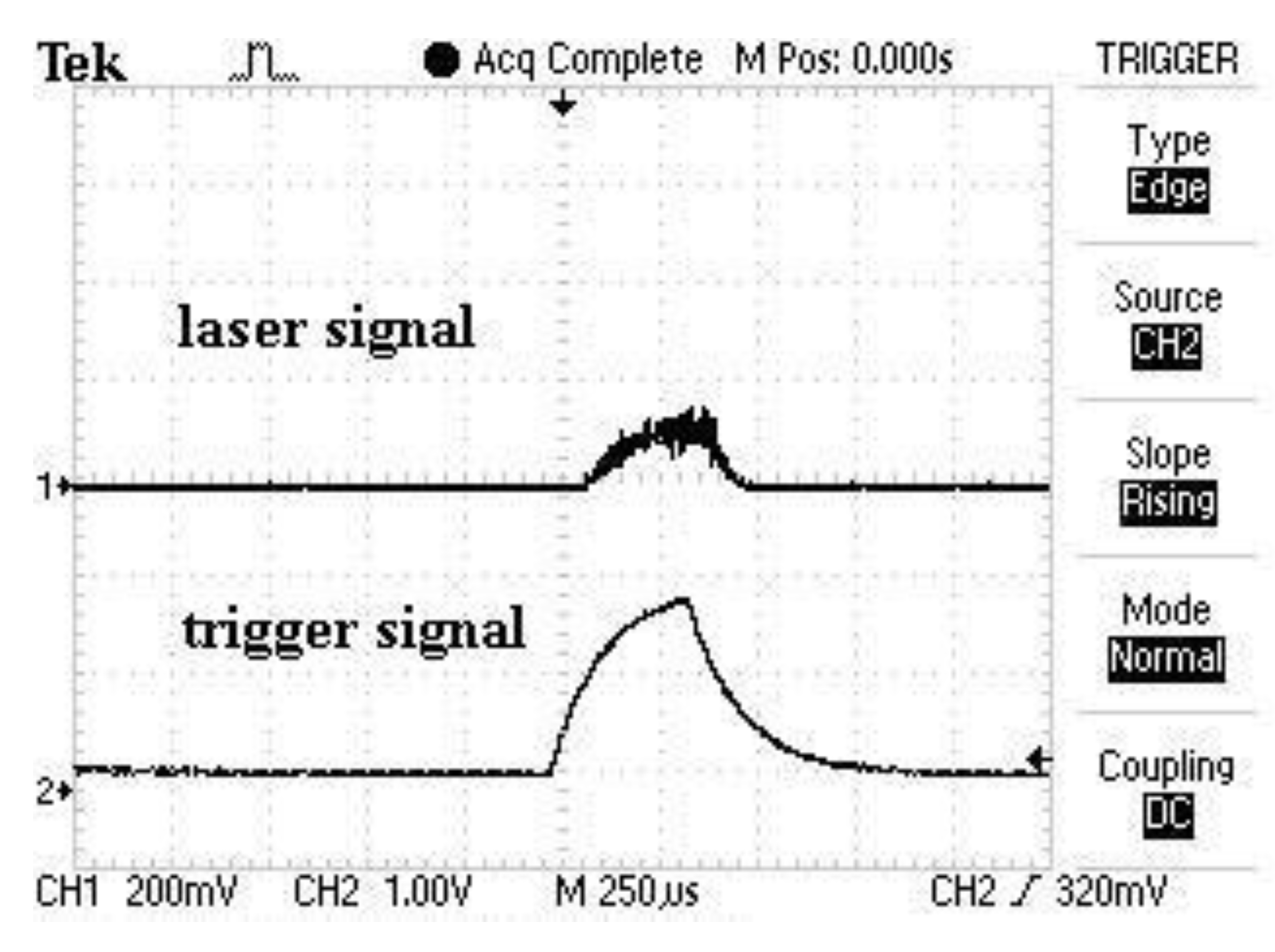
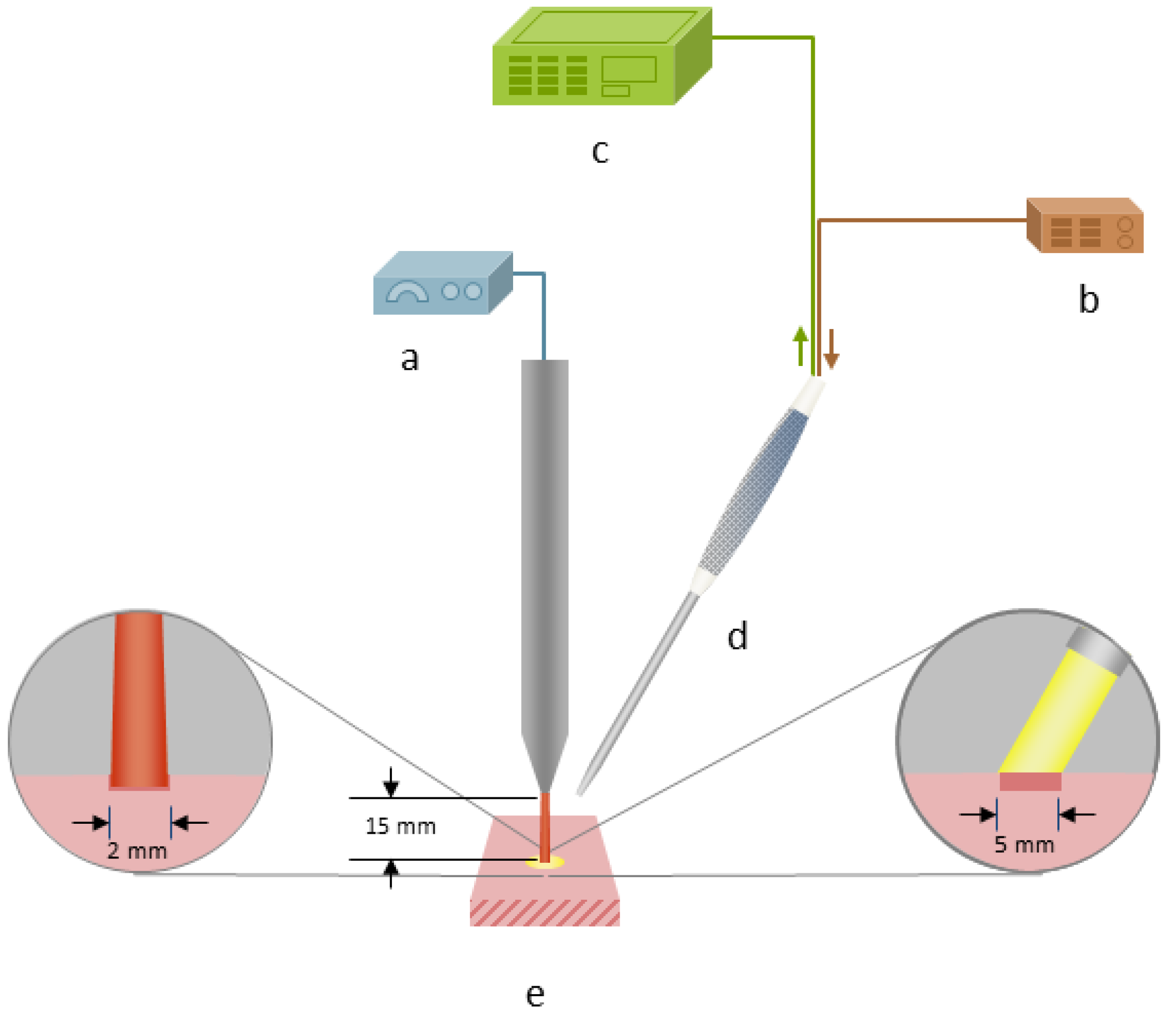
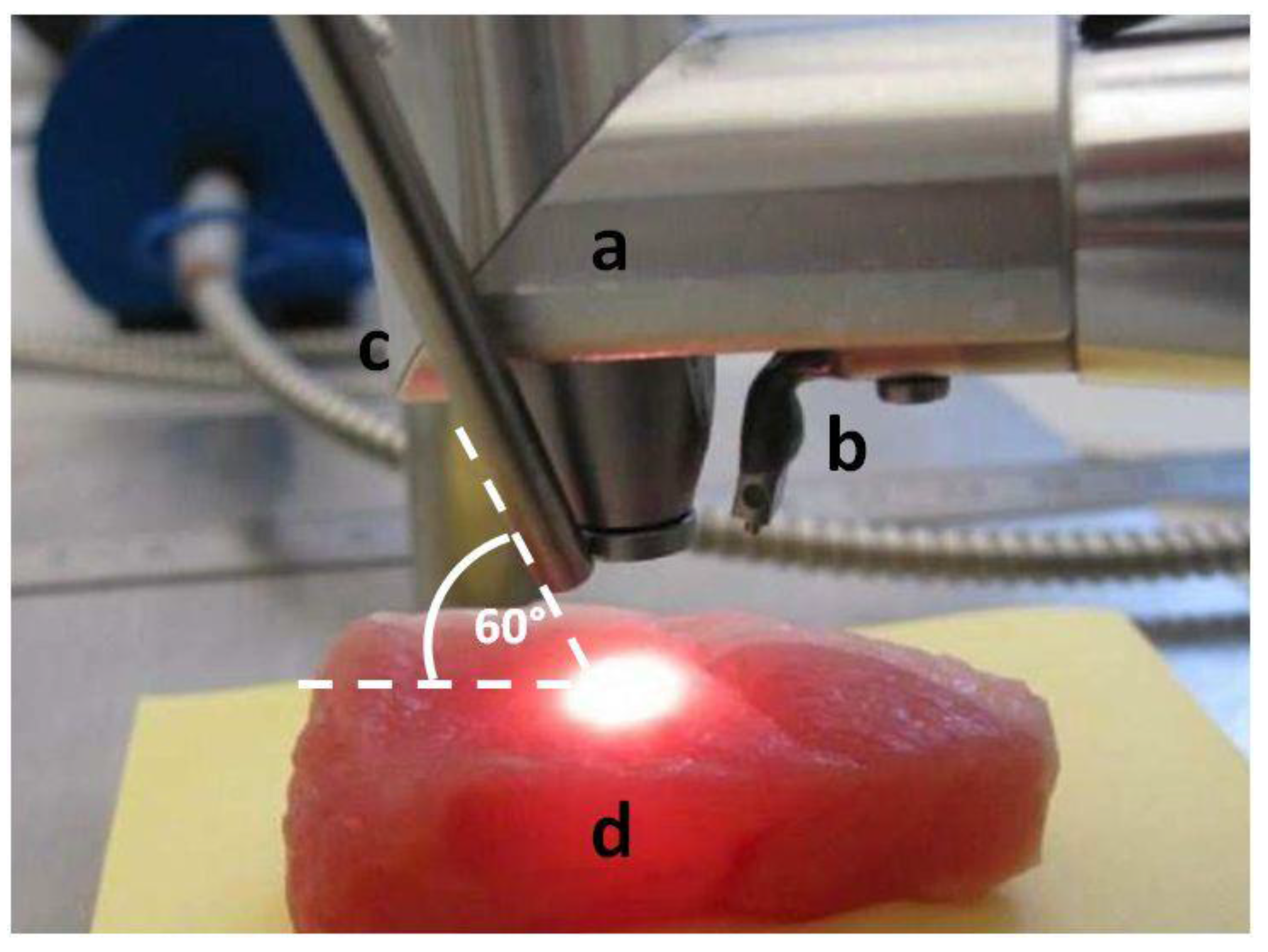
2.3. Data Processing
2.4. Statistical Analysis
3. Results and Discussion
3.1. Results
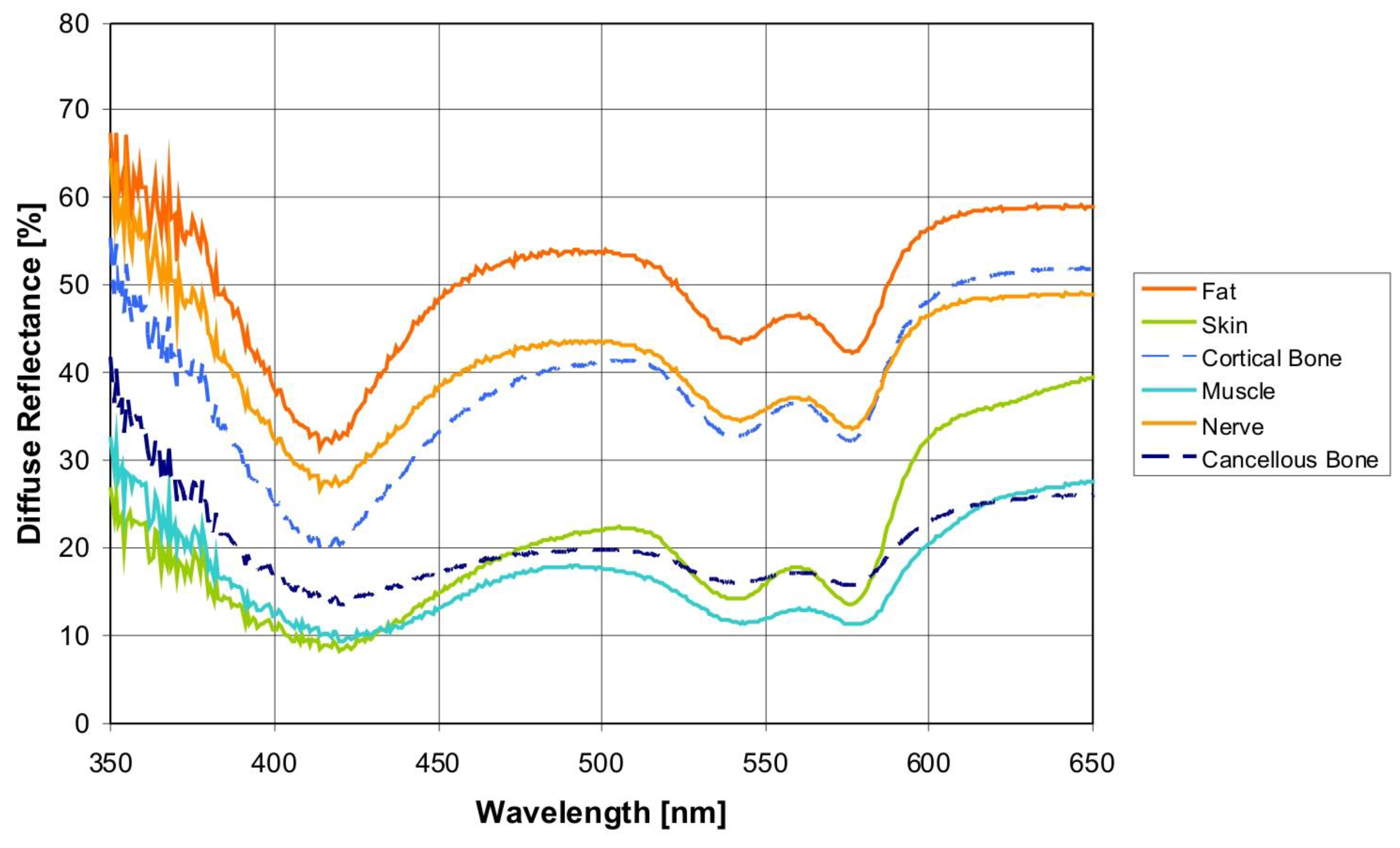
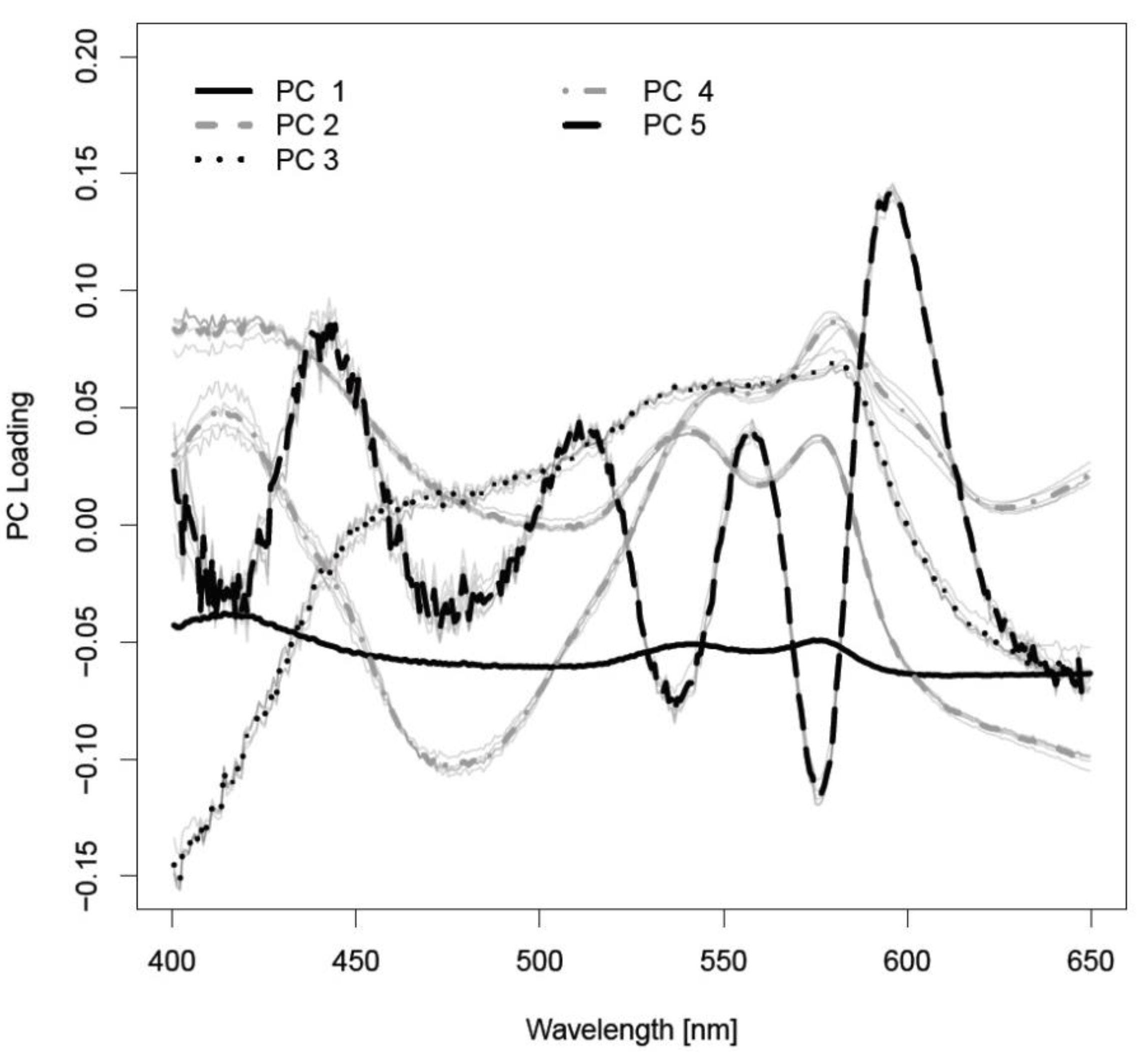
| Tissue | Classified as | |||||
|---|---|---|---|---|---|---|
| Cancellous Bone | Cortical Bone | Fat | Muscle | Nerve | Skin | |
| cancellous bone | 3375 | 697 | 0 | 2 | 397 | 0 |
| cortical bone | 2008 | 2183 | 75 | 0 | 233 | 1 |
| fat | 241 | 98 | 3105 | 0 | 905 | 62 |
| muscle | 74 | 3 | 0 | 4393 | 30 | 0 |
| nerve | 176 | 101 | 851 | 0 | 3401 | 1 |
| skin | 2 | 313 | 3 | 0 | 53 | 4129 |
| tissue specific accuracy % | 75.5 | 48.5 | 70.4 | 97.6 | 75.1 | 91.8 |
| AUC | Cancellous Bone | Cortical Bone | Fat | Muscle | Nerve |
|---|---|---|---|---|---|
| cortical bone | 0.723 | ||||
| fat | 0.979 | 0.969 | |||
| muscle | 0.987 | 0.999 | 1.000 | ||
| nerve | 0.924 | 0.953 | 0.834 | 0.998 | |
| skin | 0.998 | 0.949 | 0.998 | 1.000 | 0.992 |
| Sensitivity | Cancellous Bone | Cortical Bone | Fat | Muscle | Nerve |
|---|---|---|---|---|---|
| cortical bone | 0.533 | ||||
| fat | 0.925 | 0.939 | |||
| muscle | 0.979 | 0.999 | 1.000 | ||
| nerve | 0.949 | 0.971 | 0.723 | 1.000 | |
| skin | 0.973 | 0.929 | 0.998 | 1.000 | 0.987 |
| Specificity | Cancellous Bone | Cortical Bone | Fat | Muscle | Nerve |
|---|---|---|---|---|---|
| cortical bone | 0.824 | ||||
| fat | 0.997 | 0.976 | |||
| muscle | 1.000 | 1.000 | 1.000 | ||
| nerve | 0.895 | 0.940 | 0.823 | 0.983 | |
| skin | 1.000 | 1.000 | 0.978 | 1.000 | 1.000 |
3.2. Discussion

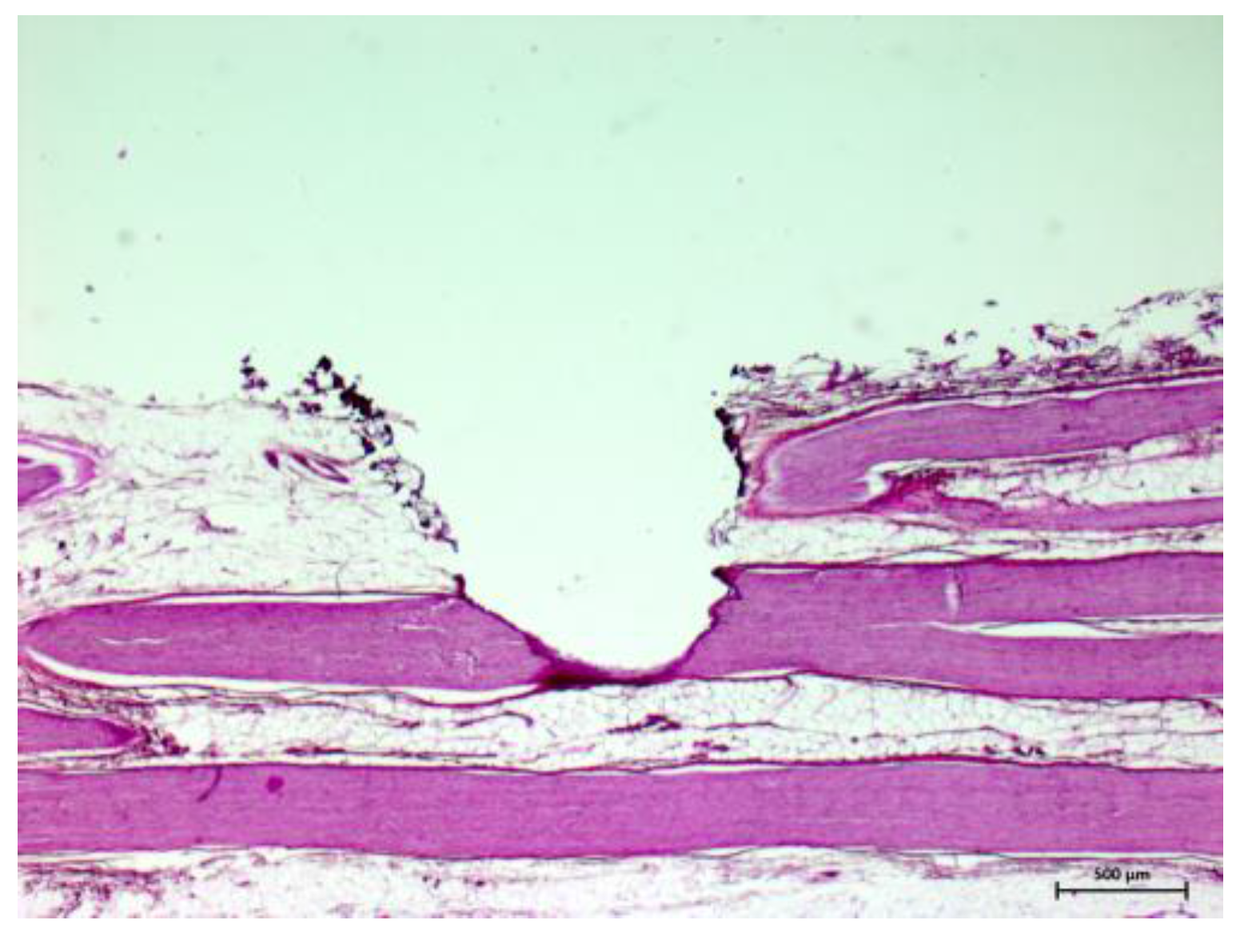
4. Conclusions
Acknowledgments
Author Contributions
Conflicts of Interest
Ethics Approval
References
- Kuttenberger, J.J.; Stubinger, S.; Waibel, A.; Werner, M.; Klasing, M.; Ivanenko, M.; Hering, P.; von Rechenberg, B.; Sader, R.; Zeilhofer, H.F. Computer-guided CO2-laser osteotomy of the sheep tibia: Technical prerequisites and first results. Photomed. Laser Surg. 2008, 26, 129–136. [Google Scholar] [CrossRef] [PubMed]
- Stopp, S.; Svejdar, D.; von Kienlin, E.; Deppe, H.; Lueth, T.C. A new approach for creating defined geometries by navigated laser ablation based on volumetric 3-D data. IEEE Trans. Biomed. Eng. 2008, 55, 1872–1880. [Google Scholar] [CrossRef] [PubMed]
- Spinelli, P.; Calarco, G.; Mancini, A.; Ni, X.G. Operative colonoscopy in cancer patients. Minim. Invasive Ther. Allied Technol. 2006, 15, 339–347. [Google Scholar] [CrossRef] [PubMed]
- Mahn, H.R.; Nowak, C.; Audring, H.; Liebetruth, J.; Lindenau, K.F. Animal experiment comparison of the therapeutic efficacy of tumor excision with a scalpel or with a CO2 laser in subcutaneously implanted Lewis lung cancer. Z. Exp. Chir. 1982, 15, 38–47. [Google Scholar] [PubMed]
- Oosterhuis, J.W.; Verschueren, R.C.; Eibergen, R.; Oldhoff, J. The viability of cells in the waste products of CO2-laser evaporation of Cloudman mouse melanomas. Cancer 1982, 49, 61–67. [Google Scholar] [CrossRef]
- Tuchmann, A.; Bauer, P.; Plenk, H., Jr.; Dinstl, K. Comparative study of conventional scalpel and CO2-laser in experimental tumor surgery. Res. Exp. Med. (Berl.) 1986, 186, 375–386. [Google Scholar] [CrossRef] [PubMed]
- Moskalik, K.; Kozlov, A.; Demin, E.; Boiko, E. The efficacy of facial skin cancer treatment with high-energy pulsed neodymium and Nd:YAG lasers. Photomed. Laser Surg. 2009, 27, 345–349. [Google Scholar] [CrossRef] [PubMed]
- Camp, A.A.; Fundakowski, C.; Petruzzelli, G.J.; Emami, B. Functional and oncologic results following transoral laser microsurgical excision of base of tongue carcinoma. Otolaryngol. Head Neck Surg. 2009, 141, 66–69. [Google Scholar] [CrossRef] [PubMed]
- Rucci, L.; Romagnoli, P.; Scala, J. CO2 laser therapy in Tis and T1 glottic cancer: Indications and results. Head Neck 2010, 32, 392–398. [Google Scholar] [PubMed]
- Le Harzic, R.; Konig, K.; Wullner, C.; Vogler, K.; Dnitzky, C. Ultraviolet femtosecond laser creation of corneal flap. J. Refract. Surg. 2009, 25, 383–389. [Google Scholar] [CrossRef] [PubMed]
- Tsuritani, M.; Watanabe, Y.; Kotani, Y.; Kataoka, T.; Ueda, H.; Hoshiai, H. Retrospective evaluation of CO2 laser conization in pregnant women with carcinoma in situ or microinvasive carcinoma. Gynecol. Obstet. Investig. 2009, 68, 230–233. [Google Scholar] [CrossRef] [PubMed]
- Baxter, G.D.; Walsh, D.M.; Allen, J.M.; Lowe, A.S.; Bell, A.J. Effects of low intensity infrared laser irradiation upon conduction in the human median nerve in vivo. Exp. Physiol. 1994, 79, 227–234. [Google Scholar] [CrossRef] [PubMed]
- Menovsky, T.; van den Bergh Weerman, M.; Beek, J.F. Effect of CO2 milliwatt laser on peripheral nerves: Part I. A dose-response study. Microsurgery 1996, 17, 562–567. [Google Scholar] [CrossRef]
- Menovsky, T.; van den Bergh Weerman, M.; Beek, J.F. Effect of CO2-Milliwatt laser on peripheral nerves: Part II. A histological and functional study. Microsurgery 2000, 20, 150–155. [Google Scholar] [CrossRef]
- Marchesi, M.; Biffoni, M.; Trinchi, S.; Turriziani, V.; Campana, F.P. Facial nerve function after parotidectomy for neoplasms with deep localization. Surg. Today 2006, 36, 308–311. [Google Scholar] [CrossRef] [PubMed]
- Bron, L.P.; OʼBrien, C.J. Facial nerve function after parotidectomy. Arch. Otolaryngol. Head Neck Surg. 1997, 123, 1091–1096. [Google Scholar] [CrossRef] [PubMed]
- Colella, G.; Cannavale, R.; Vicidomini, A.; Lanza, A. Neurosensory disturbance of the inferior alveolar nerve after bilateral sagittal split osteotomy: A systematic review. J. Oral Maxillofac. Surg. 2007, 65, 1707–1715. [Google Scholar] [CrossRef] [PubMed]
- Yoshida, T.; Nagamine, T.; Kobayashi, T.; Michimi, N.; Nakajima, T.; Sasakura, H.; Hanada, K. Impairment of the inferior alveolar nerve after sagittal split osteotomy. J. Cranio Maxillo Fac. Surg. 1989, 17, 271–277. [Google Scholar] [CrossRef]
- Van Sickels, J.E.; Hatch, J.P.; Dolce, C.; Bays, R.A.; Rugh, J.D. Effects of age, amount of advancement, and genioplasty on neurosensory disturbance after a bilateral sagittal split osteotomy. J. Oral Maxillofac. Surg. 2002, 60, 1012–1017. [Google Scholar] [CrossRef] [PubMed]
- Araya, J.; Martinez, R.; Niklander, S.; Marshall, M.; Esguep, A. Incidence and prevalence of salivary gland tumours in Valparaiso, Chile. Med. Oral Patol. Oral Cir. Bucal 2015, 20, e532–e539. [Google Scholar] [CrossRef] [PubMed]
- Luksic, I.; Virag, M.; Manojlovic, S.; Macan, D. Salivary gland tumours: 25 years of experience from a single institution in Croatia. J. Cranio Maxillo Fac. Surg. 2012, 40, e75–e81. [Google Scholar] [CrossRef] [PubMed]
- Cheong, W.F.; Prahl, S.A.; Welch, A.J. A review of the optical properties of biological tissues. IEEE J. Sel. Top. Quantum Electron. 1990, 26, 2166–2185. [Google Scholar] [CrossRef]
- Taroni, P.; Pifferi, A.; Torricelli, A.; Comelli, D.; Cubeddu, R. In vivo absorption and scattering spectroscopy of biological tissues. Photochem. Photobiol. Sci. 2003, 2, 124–129. [Google Scholar] [CrossRef] [PubMed]
- Bashkatov, A.N.; Genina, E.A.; Kochubey, V.I.; Tuchin, V.V. Optical properties of human skin, subcutaneous and mucous tissues in the wavelength range from 400 to 2000 nm. J. Phys. D Appl. Phys. 2005, 38, 2543–2555. [Google Scholar] [CrossRef]
- Prasad, P.N. Bioimaging: Principles and Techniques. In Introduction to Biophotonics; John Wiley & Sons, Inc.: Hoboken, NJ, USA, 2004; pp. 203–254. [Google Scholar]
- Wallace, V.P.; Crawford, D.C.; Mortimer, P.S.; Ott, R.J.; Bamber, J.C. Spectrophotometric assessment of pigmented skin lesions: Methods and feature selection for evaluation of diagnostic performance. Phys. Med. Biol. 2000, 45, 735–751. [Google Scholar] [CrossRef] [PubMed]
- Bensalah, K.; Peswani, D.; Tuncel, A.; Raman, J.D.; Zeltser, I.; Liu, H.; Cadeddu, J. Optical reflectance spectroscopy to differentiate benign from malignant renal tumors at surgery. Urology 2009, 73, 178–181. [Google Scholar] [CrossRef] [PubMed]
- Fawzy, Y.S.; Petek, M.; Tercelj, M.; Zeng, H. In vivo assessment and evaluation of lung tissue morphologic and physiological changes from non-contact endoscopic reflectance spectroscopy for improving lung cancer detection. J. Biomed. Opt. 2006, 11. [Google Scholar] [CrossRef] [PubMed]
- Nilsson, A.M.; Heinrich, D.; Olajos, J.; Andersson-Engels, S. Near infrared diffuse reflection and laser-induced fluorescence spectroscopy for myocardial tissue characterisation. Spectrochim. Acta Part A Mol. Biomol. Spectrosc. 1997, 53A, 1901–1912. [Google Scholar] [CrossRef]
- Rocha, R.; Villaverde, A.B.; Silveira, L., Jr.; Brugnera, A., Jr.; Alves, L.P.; Munin, E.; Rodrigues, K.C.; Pasqualucci, C.A.; Pacheco, M.T. Fluorescence and reflectance spectroscopy for identification of atherosclerosis in human carotid arteries using principal components analysis. Photomed. Laser Surg. 2008, 26, 329–335. [Google Scholar] [CrossRef] [PubMed]
- Stelzle, F.; Tangermann-Gerk, K.; Adler, W.; Zam, A.; Schmidt, M.; Douplik, A.; Nkenke, E. Diffuse reflectance spectroscopy for optical soft tissue differentiation as remote feedback control for tissue-specific laser surgery. Lasers Surg. Med. 2010, 42, 319–325. [Google Scholar] [CrossRef] [PubMed]
- Stelzle, F.; Zam, A.; Adler, W.; Tangermann-Gerk, K.; Douplik, A.; Nkenke, E.; Schmidt, M. Optical Nerve Detection by Diffuse Reflectance Spectroscopy for Feedback Controlled Oral and Maxillofacial Laser Surgery. J. Transl. Med. 2011, 9. [Google Scholar] [CrossRef] [PubMed]
- Stelzle, F.; Knipfer, C.; Bergauer, B.; Rohde, M.; Adler, W.; Tangermann-Gerk, K.; Nkenke, E.; Schmidt, M. Optical nerve identification in head and neck surgery after Er:YAG laser ablation. Lasers Med. Sci. 2014, 29, 1641–1648. [Google Scholar] [CrossRef] [PubMed]
- Stelzle, F.; Terwey, I.; Knipfer, C.; Adler, W.; Tangermann-Gerk, K.; Nkenke, E.; Schmidt, M. The impact of laser ablation on optical soft tissue differentiation for tissue specific laser surgery—An experimental ex vivo study. J. Transl. Med. 2012, 10. [Google Scholar] [CrossRef] [PubMed]
- Stelzle, F.; Adler, W.; Zam, A.; Tangermann-Gerk, K.; Knipfer, C.; Douplik, A.; Schmidt, M.; Nkenke, E. In vivo optical tissue differentiation by diffuse reflectance spectroscopy: Preliminary results for tissue-specific laser surgery. Surg. Innov. 2012, 19, 385–393. [Google Scholar] [CrossRef] [PubMed]
- R Development Core Team. R: A Language and Environment for Statistical Computing; R Foundation for Statistical Computing: Vienna, Austria, 2008. [Google Scholar]
- Peters, A.; Hothorn, T. ipred: Improved Predictors. R package version 0.8-8. Available online: http://CRAN.R-project.org/package=ipred (accessed on 10 October 2013).
- Potapov, S.; Adler, W.; Lausen, B. Daim: Diagnostic Accuracy of Classification Models. Available online: http://cran.r-project.org/web/packages/Daim/index.html (accessed on 10 October 2013).
- Chan, E.K.; Sorg, B.; Protsenko, D.; OʼNeil, M.; Motamedi, M.; Welch, A.J. Effects of compression on soft tissue optical properties. IEEE J. Sel. Top. Quantum. Electron. 1996, 2, 943–950. [Google Scholar] [CrossRef]
- Nath, A.; Rivoire, K.; Chang, S.; Cox, D.; Atkinson, E.N.; Follen, M.; Richards-Kortum, R. Effect of probe pressure on cervical fluorescence spectroscopy measurements. J. Biomed. Opt. 2004, 9, 523–533. [Google Scholar] [CrossRef] [PubMed]
- Reif, R.; Amorosino, M.S.; Calabro, K.W.; AʼAmar, O.; Singh, S.K.; Bigio, I.J. Analysis of changes in reflectance measurements on biological tissues subjected to different probe pressures. J. Biomed. Opt. 2008, 13. [Google Scholar] [CrossRef] [PubMed]
- Ti, Y.; Lin, W.C. Effects of probe contact pressure on in vivo optical spectroscopy. Opt. Express 2008, 16, 4250–4262. [Google Scholar] [CrossRef] [PubMed]
- Liao, H.; Fujiwara, K.; Ando, T.; Maruyama, T.; Kobayashi, E.; Muragaki, Y.; Iseki, H.; Sakuma, I. Automatic laser scanning ablation system for high-precision treatment of brain tumors. Lasers Med. Sci. 2013, 28, 891–900. [Google Scholar] [CrossRef] [PubMed]
- Liao, H.; Noguchi, M.; Maruyama, T.; Muragaki, Y.; Kobayashi, E.; Iseki, H.; Sakuma, I. An integrated diagnosis and therapeutic system using intra-operative 5-aminolevulinic-acid-induced fluorescence guided robotic laser ablation for precision neurosurgery. Med. Image Anal. 2012, 16, 754–766. [Google Scholar] [CrossRef] [PubMed]
- Ross, M.H.; Pawlina, W. Histology: A Text and Atlas: With Correlated Cell and Molecular Biology; Lippincott Williams & Wilkins: Baltimore, MD, USA, 2006. [Google Scholar]
- Tangermann, K.; Uller, J. Einsatz eines ER:YAG-Lasers in der Mund-, Kiefer-, Gesichtschirurgie. Laser Opto 2001, 1, 40–45. [Google Scholar]
- Geiger, M.; Meier, T.; Technologien, T.P. Bewertung von Abbrandprodukten bei der Medizinischen Laseranwendung; VDI-Technologiezentrum Physikalische Technologien: Düsseldorf, Germany, 1996. [Google Scholar]
- Lukianova-Hleb, E.Y.; Oginsky, A.O.; Olson, J.S.; Lapotko, D.O. Short laser pulse-induced irreversible photothermal effects in red blood cells. Lasers Surg. Med. 2011, 43, 249–260. [Google Scholar] [CrossRef] [PubMed]
- Strauss, R.A.; Fallon, S.D. Lasers in contemporary oral and maxillofacial surgery. Dent. Clin. North Am. 2004, 48, 861vi–888vi. [Google Scholar] [CrossRef] [PubMed]
- Luerssen, K.; Lubatschowski, H.; Ptok, M. Erbium:YAG laser surgery on vocal fold tissue. HNO 2007, 55, 443–446. [Google Scholar] [PubMed]
- Boppart, S.A.; Herrmann, J.; Pitris, C.; Stamper, D.L.; Brezinski, M.E.; Fujimoto, J.G. High-resolution optical coherence tomography-guided laser ablation of surgical tissue. J. Surg. Res. 1999, 82, 275–284. [Google Scholar] [CrossRef] [PubMed]
- Horch, H. Laser in der Zahnärztlichen- und Mund-Kiefer-Gesichtschirurgie; Ecomed Verlag: Landsberg-München-Zürich, Switzerland, 1993. [Google Scholar]
- Keller, U.; Hibst, R. Lasersysteme für die Orale Hart- und Weichgewebschirurgie—Gewebewirkungen und Indikationen; Gustav Fischer Verlag: Stuttgart, Germany, 1994. [Google Scholar]
- Romanos, G.; Ko, H.H.; Froum, S.; Tarnow, D. The use of CO2 laser in the treatment of peri-implantitis. Photomed. Laser Surg. 2009, 27, 381–386. [Google Scholar] [CrossRef] [PubMed]
- Ye, Z.; Auner, G. Principal component analysis approach for biomedical sample identification. In Proceedings of the 2004 IEEE International Conference on Systems, Man and Cybernetics, The Hague, Netherlands, 10–13 October 2004; pp. 1348–1353.
- Palmer, G.M.; Marshek, C.L.; Vrotsos, K.M.; Ramanujam, N. Optimal methods for fluorescence and diffuse reflectance measurements of tissue biopsy samples. Lasers Surg. Med. 2002, 30, 191–200. [Google Scholar] [CrossRef] [PubMed]
- Salomatina, E.; Yaroslavsky, A.N. Evaluation of the in vivo and ex vivo optical properties in a mouse ear model. Phys. Med. Biol. 2008, 53, 2797–2808. [Google Scholar] [CrossRef] [PubMed]
© 2015 by the authors; licensee MDPI, Basel, Switzerland. This article is an open access article distributed under the terms and conditions of the Creative Commons Attribution license (http://creativecommons.org/licenses/by/4.0/).
Share and Cite
Bergauer, B.; Knipfer, C.; Amann, A.; Rohde, M.; Tangermann-Gerk, K.; Adler, W.; Schmidt, M.; Nkenke, E.; Stelzle, F. Does Laser Surgery Interfere with Optical Nerve Identification in Maxillofacial Hard and Soft Tissue?—An Experimental Ex Vivo Study. Sensors 2015, 15, 25416-25432. https://doi.org/10.3390/s151025416
Bergauer B, Knipfer C, Amann A, Rohde M, Tangermann-Gerk K, Adler W, Schmidt M, Nkenke E, Stelzle F. Does Laser Surgery Interfere with Optical Nerve Identification in Maxillofacial Hard and Soft Tissue?—An Experimental Ex Vivo Study. Sensors. 2015; 15(10):25416-25432. https://doi.org/10.3390/s151025416
Chicago/Turabian StyleBergauer, Bastian, Christian Knipfer, Andreas Amann, Maximilian Rohde, Katja Tangermann-Gerk, Werner Adler, Michael Schmidt, Emeka Nkenke, and Florian Stelzle. 2015. "Does Laser Surgery Interfere with Optical Nerve Identification in Maxillofacial Hard and Soft Tissue?—An Experimental Ex Vivo Study" Sensors 15, no. 10: 25416-25432. https://doi.org/10.3390/s151025416
APA StyleBergauer, B., Knipfer, C., Amann, A., Rohde, M., Tangermann-Gerk, K., Adler, W., Schmidt, M., Nkenke, E., & Stelzle, F. (2015). Does Laser Surgery Interfere with Optical Nerve Identification in Maxillofacial Hard and Soft Tissue?—An Experimental Ex Vivo Study. Sensors, 15(10), 25416-25432. https://doi.org/10.3390/s151025416





